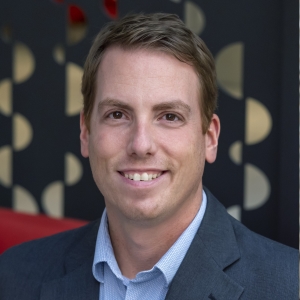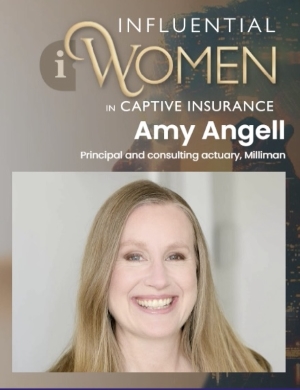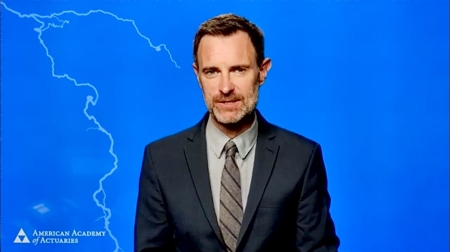Casualty Quarterly, Summer 2024
Vol. 8 | No. 3
Date:06/03/2024
New Homeowners’ Insurance Task Force Outlines Key Issues, Seeks Volunteers

Doss

CasehartThe Casualty Practice Council’s (CPC) new Homeowners’ Insurance Task Force will look at a variety of public policy issues related to homeowners’ insurance. The task force is looking for volunteers-if interested in joining as a founding member, please fill out the volunteer contact form. (Please make sure to note you are interested in joining this task force. Learn more about volunteering at the Academy’s free Volunteer Information Session webinar on Aug. 6-register here.)
The task force is charged with providing an actuarial viewpoint on homeowners’ insurance public policy issues, including but not limited to availability and affordability concerns in many states-including Florida, California, and others-that are disproportionately affected by extreme events such as hurricanes and wildfires.
Casualty Quarterly asked Chairperson Ken Doss and Vice Chairperson Emma Casehart about some of the new task force’s plans and goals.
What are some of the key issues facing the new task force?
At a time when catastrophic events are becoming more prevalent, people continue building and buying homes closer to where these events most frequently occur. This has contributed to concerns with the affordability and availability of homeowners’ insurance in many markets. The task force, in connection with the Casualty Practice Council’s P/C Extreme Events Committee, will consider major drivers of availability and affordability concerns and potential remedies. Current markets will be used as case studies into how they became stressed, and what actions can be taken to enhance availability and affordability for customers. Research will include several perspectives:
- What are major drivers of increased losses, and are some of those drivers unrelated to increased risk (e.g., fraud)?
- How can risk mitigation measures, and enhanced education around these opportunities, improve availability and affordability?
- How has regulatory/legislative action influenced the situation, and what tactics can be leveraged to enhance availability and affordability?
- In what ways can homeowners be educated about the issues and informed in how their decisions can influence the situation?
With this summer’s record heat, how important are climate-related issues for homeowners’ insurance?
The task force will focus on climate issues as they relate to availability and affordability for homeowners. Those issues are interrelated with work by the Academy’s Climate Change Joint Committee, which published the recent issue paper Climatic Events, Inequities, and Risk Mitigation, and the Extreme Events Committee. A home itself may be more affordable in a high-risk area for a first-time homebuyer, but it has hidden costs of high insurance premiums, time to rebuild a home, and the stress of losing cherished possessions in a disaster. Insurance may not even be available in certain areas, leaving Americans scrambling to find coverage to protect what is often their largest financial investment. The task force will focus on how changes in climate lead to changes in insured events, with a focus on the financial system and tools that individuals and public policymakers can use to improve their resilience.
California in particular has been in the news because of regulatory issues affecting homeowners’ insurance. Generally speaking, are these issues ongoing or are they becoming more resolved?
California is an ever-evolving market and will be an impactful case study for the task force in analyzing what has caused issues of availability and affordability in the state. California’s unique environment and path to get here will provide ample opportunity to learn and inform the work of the task force. While it is too soon to say whether issues are resolved, there have been positive developments that can help with availability challenges in the state. Other areas of the Academy have engaged in this discussion, including the Extreme Events and Property Lines Committee, which sent a comment letter on catastrophe modeling to the California Department of Insurance in April, and updated a wildfire issue paper in 2022 that was originally released on 2019.
What types of deliverables is the task force planning?
The ultimate form of the deliverables will be determined by the membership of the committee, though the learnings and solutions developed by the group can be shared in a number of actuarial forums, including webinars, issue briefs, or articles in Contingencies. The task force may have opportunities to also present deliveries in regulatory/legislative forums like NAIC [the National Association of Insurance Commissioners] or NCOIL [the National Council of Insurance Legislators].
Given ongoing public policy discussions, how does the issue of the affordability of housing-both as a matter of people buying first homes and the ongoing costs of home ownership-fit into these considerations, given that both title insurance and homeowners’ policies are in the mix in those discussions?
Homeowners’ insurance exists only when home ownership exists. If home ownership is affordable only in areas with more risk to the property, that affordability of the property may lead to higher financial costs in the form of higher insurance risk, lack of market value appreciation, or difficulty selling the property in the future as the risk profile of the area shifts. The Homeowners’ Insurance Task Force will focus on the risks posed to properties across the United States from many perils and how the insurance industry and policymakers can respond to these risks.
While wildfire is an ongoing major risk, both tropical and convective storms-including hail-cause more damage than wildfires. How do these factors fit into the homeowners’ insurance mix?
As many industry professionals know, severe convective storms have been a growing topic of conversation for a number of years. These storms often produce straight-line winds and hail that damage roofs. This traditional secondary peril is being elevated to the status of a major peril for many insurers, causing significant damage potentially on par with that of hurricanes. The task force is committed to work with the Extreme Events Committee and the Climate Change Joint Committee as needed to publicize how severe convective storms affect insurance availability and affordability, and policy options that can improve building and community resilience to these storms.
Given that we are publishing at the height of the summer, some of this is focused on the perils related to hot weather. But homeowners face perils year-round-are there seasonal variations in claims and will you be looking into a resource guide for homeowners looking to prepare for the most likely eventualities?
The task force will plan to research various reasons homeowners incur claims and any variation that occurs throughout the year. One important goal of the task force is to provide information to better educate homeowners. This includes not only preparation for potential losses, but how their decisions impact potential future losses and the premiums they pay for coverage.
Susan Kent Nominated to Be Next Casualty VP

KentSusan Kent was nominated to be casualty vice president, succeeding Amy Angell. Kent became chairperson of the P/C Committee on Equity and Fairness late last year and has served on the committee since 2022, testifying in several public forums including most recently in the District of Columbia. She also offered a Q&A on P/C bias issues in the Spring 2023 Casualty Quarterly.
“I am honored to be nominated for casualty vice president,” Kent said. “Over the past several years, I have greatly valued the opportunity to collaborate with numerous volunteers and Academy staff. As we face a range of challenges in property and casualty insurance, I am eager to continue working with the Casualty Practice Council and our various committees to address these issues and new opportunities.”
The Academy’s leadership transition will occur in mid-November this year, as the annual meeting will be held earlier, in mid-October.
VP Amy Angell Recognized as Influential Woman in Insurance Industry
Casualty Vice President Amy Angell was recognized by Captive International magazine as one of the most influential women in captive insurance. In a Q&A, Angell discusses how she got started in the actuarial profession, her inspiration, and some of the gender-specific challenges-and solutions-for women in the industry.

Early Discounts End Aug. 2 for September’s CLRS

Sponsored jointly by the Academy and the Casualty Actuarial Society, the annual Casualty Loss Reserve Seminar (CLRS) offers highly interactive sessions to help P/C actuaries stay fresh on relevant topics, maintain credentials, and grow their network.
Academy Senior Casualty Fellow Rich Gibson, who is involved with CLRS planning, calls the event “one of the best continuing education opportunities for reserving actuaries,” noting its intensive workshops and general sessions on leadership, international capital standards, and technology in reserving, with nearly 50 concurrent sessions and eight roundtable discussions.
“It’s a great opportunity to network with other Academy and COPLFR [Committee on Property and Liability Financial Reporting] members,” Gibson said.
The event will also include featured speaker Ryan Gottfredson, a leadership development author, researcher, and consultant who helps organizations develop leaders primarily through a focus on mindsets. Gottfredson is the bestselling author of Success Mindsets: The Key to Unlocking Greater Success in Your Life, Work, & Leadership and The Elevated Leader: Leveling Up Your Leadership Through Vertical Development, and is also a leadership professor at the College of Business and Economics at California State University-Fullerton. He will speak in a Sept. 9 session that will be livestreamed.
CLRS will be held Sept. 9 to 11 in San Francisco, with a livestream option. Early registration discounts end Friday, Aug. 2-register today.
Register for the Academy’s P/C Opinion Seminar, Coming to New Orleans in December
Early-bird discounts are available for the annual Seminar on Effective P/C Loss Reserve Opinions, Dec. 9-10 in New Orleans.
Called by one past attendee “a great distillation of changing requirements and rules, as well as a good pooling of experience,” the seminar is designed for P/C actuaries who prepare NAIC statements of actuarial opinion.
Check out the agenda, which includes sessions on reserve ranges, “when things go awry,” and an optional Day 2 workshop on ASOP No. 36, Statements of Actuarial Opinion Regarding Property/Casualty Loss, Loss Adjustment Expense, or Other Reserves. Register today.
The Academy is accepting names of members interested in serving as an Actuarial Standards Board (ASB) property/casualty member. There will be a need to fill one position with a volunteer from the P/C area for a three-year term beginning Jan. 1, 2025. If you are interested in being considered, please review the ASB selection criteria and complete the survey here. Nominations are due by Aug. 26.
ASB Approves ASOP No. 30 Exposure Draft
The ASB approved an exposure draft of a proposed revision of Actuarial Standard of Practice (ASOP) No. 30, now titled Profit Margins and Contingency Provisions in Property/Casualty Risk Transfer and Risk Retention. Changes from the existing standard include broadening the scope from estimating capital cost, and evaluating underwriting profit and contingency provisions. The proposed revision allows ASOP No. 53, Estimating Future Costs for Prospective Property/Casualty Risk Transfer and Risk Retention, to govern with respect to appropriate intended measures. The comment deadline is Nov. 1-to comment, see the exposure draft.
August Webinar to Examine Workers’ Comp Issues
An August P/C webinar, Diamonds in the Rough: A Discussion of Lesser-Known Workers’ Compensation Resources for Actuaries, will examine a variety of resources used by actuaries in workers’ compensation work. It will feature presenters from the Workers’ Compensation Research Institute, the New York Workers’ Compensation Board, and the Oregon Department of Consumer and Business Services. Mark Priven, a member of the CPC’s Workers’ Compensation Committee, will moderate. The webinar is set for Aug. 20-register today.
Free Webinars With FIO, NSF Cover Cyber/Terrorism Issues
The Academy hosted two free July webinars in conjunction with the Federal Insurance Office (FIO) and the National Science Foundation (NSF), on the topics of cyber risk, terrorism, and underwriting. More than 300 people attended the webinars.
The July 9 webinar was moderated by Academy President Lisa Slotznick. Update on Proposed Industry-University Cooperative Research Centers (IUCRC) on Terrorism and Catastrophic Cyber Insurance. Part One featured FIO Director Steven Seitz; FIO Senior Insurance Regulatory Policy Analyst Chanda Brady; and NSF IUCRC Program Director Mohan Kumar. Watch a replay on the Academy’s YouTube channel.
In Part Two, on July 16, moderators Committee on Cyber Risk Chairperson Wanchin Chou, Seitz, and Brady led a panel that discussed market challenges and potential areas for research and improvement in modeling and underwriting. Watch it on the Academy’s YouTube channel.
Cyber Resources-For more information on the Academy portfolio of cyber-related resources, including the Cyber Risk Toolkit, visit the P/C public policy webpage
Academy Participates in FIO Conference on Cyber-Incident Response
Casualty Policy Analyst Rob Fischer participated in a mid-May FIO conference, which featured senior stakeholders from Department of the Treasury, the Cybersecurity and Infrastructure Security Agency, and the Office of the National Cyber Director, along with cyber insurers and reinsurers. They discussed potential protection gaps, the size of the cyber market, and what forms a federal cyber backstop could take.
Highlights From Casualty Quarterly

Prefer to watch your news? Check out this “Highlights From Casualty Quarterly” video for a quick recap of what you need to know.
Envision Tomorrow: Casualty Agenda Preview
Register early and get a discount to Register early and get a discount to Envision Tomorrow, the Academy’s annual meeting to be held Oct. 15-16 at the Grand Hyatt Washington in the nation’s capital, with the theme of “Exploring a World of Risk.”
Former NATO Supreme Allied Commander Gen. Wesley Clark will give the opening keynote address on leadership, global risks, and the U.S. political landscape, and financial and insurance inclusion researcher Leroy Nunery II will lead a discussion on “Growing Financial Inclusion.”
P/C Breakout Sessions
Property/casualty breakout sessions will include Florida and California regulatory reform; “The Long Hot Summer,” a climate session identifying and measuring the impact of mitigation solutions for extreme weather events; and “Cost Drivers in P/C Insurance,” in which panelists will discuss cost drivers and pressure points with considerations of affordability, availability, and public policy impacts.
Get your early-bird discount-register today.
The Committee on Property and Liability Financial Reporting asked NAIC’s Actuarial Opinion Working Group for clarification on 2024 regulatory guidance pertaining to immaterial long-duration unearned premium reserves.
The Climate Change Joint Committee released an issue paper, Climatic Events, Inequities, and Risk Mitigation, which focuses on the cause-and-effect relationship that different climatic events have on different U.S. populations and communities that disproportionately experience the effects of climate change.
An Academy Actuarially Sound blog post covers the brewing 2024 hurricane season and its effect on P/C insurers.
P/C Committee on Equity and Fairness Chairperson (and Academy Casualty VP nominee) Susan Kent spoke at a June 7 public hearing of the District of Columbia Department of Insurance, Securities & Banking (DISB) on DISB’s Market Conduct Examination Draft Report-Evaluating Unintentional Bias in Private Passenger Automobile Insurance.
The P/C Committee on Equity and Fairness sent a comment letter to DISB on a recently released draft market conduct study, Evaluating Unintentional Bias in Private Passenger Automobile Insurance..
The Actuaries Climate Index was used as a data source for new research on the association of excess mortality and extreme temperatures published in the peer-reviewed journal BMC Public Health. The index’s methodology was also used by researchers to explore the negative effects of weather shocks on GDP and credit for nonfinancial firms in China, in a paper published in the Journal of Economic Behavior & Organization.
Legislative/Regulatory Activity
NAIC
The NAIC adopted a modification to the Annual Statement blank that requires the filer to include 10 years of experience for Schedule P in all lines of business beginning in 2024. This change eliminates the distinction between “short-tailed” and “long-tailed” lines of business in Schedule P.
Federal
The Federal Emergency Management Agency (FEMA) finalized a rule on July 11 mandating that projects built using its funds not only take into account previous and current levels of local flood risk, but for the first time consider the future risk of flooding, which is being exacerbated by climate change. Federal officials said that the updated Federal Flood Risk Management Standard-which goes into effect Sept. 9-should make communities more resilient and save taxpayers money by preventing repeat building of vulnerable structures in flood zones.
Insurers that paid out policies as a result of a deadly 2016 Tennessee wildfire can pursue more claims against the federal government, following the U.S. Court of Appeals for the Sixth Circuit June 28 reversal of a lower court’s ruling shielding the government from part of the insurers’ claims. The ruling came nearly a year after the appeals court revived the Tennessee residents’ claims against the National Park Service for failing to adequately warn them of the wildfire.
The Department of Housing and Urban Development (HUD) approved a final rule revising existing HUD regulations in an attempt to improve the resilience of HUD-assisted or HUD-financed projects to natural disasters and the effects of climate change when it comes to flooding. The rule revises HUD’s floodplain regulations in an effort to modernize standards.
The Senate approved by a voice vote an amended version of S 2958 offered by Sen. Thomas Carper of Delaware. The amendment, among other changes, permits private residential property owners whose dwellings were previously part of the Coastal Barriers Resource System to purchase flood insurance under the National Flood Insurance Program for the first time.
State
New York’s Department of Financial Services adopted final guidance in early July aimed at preventing algorithmic discrimination in insurance, including a requirement for carriers to keep close tabs on their use of external data sources. Under the guidance, insurers that use AI must prove that the models don’t use or act as a proxy for protected characteristics before using them in underwriting and pricing.
Colorado Gov. Jared Polis signed legislation in mid-May that is considered by some to be the most far-reaching regulations on artificial intelligence (AI) in the nation. SB 24-205 requires insurers and other businesses to take steps to prevent potential bias from AI products. The mandates include conducting impact assessments and giving customers details of the data used to train their AI models.
Polis also signed HB 24-1108, requiring the state’s insurance commissioner to conduct a study looking at the market for property and casualty insurance policies issued by insurers to unit owners’ associations of common interest communities, as well as owners of hotels and lodging facilities. He also approved HB 24-1060, a bill adopting, in part, the NAIC’s travel insurance model act. The language provides a legal framework for the sale of travel insurance in the state.
The Texas Department of Insurance approved on May 31 the liquidity stress test framework previously adopted by NAIC, requiring insurance providers file results each year by June 30.
Florida Gov. Ron DeSantis signed HB 293 in late May, which requires homeowners’ associations to adopt hurricane protection specifications that conform to building codes. The law also prohibits homeowners’ associations from denying applications to install certain hurricane protection elements.
DeSantis also signed HB 1503, revising circumstances under which the state’s property insurer of last resort, Citizens Property Insurance Corporation, may levy market equalization surcharges on policyholders, and signed HB 1049, requiring resident property sellers to make certain flood disclosures to property buyers.
Maryland Gov. Wes Moore signed SB 148, requiring at least 40% of funds used by the state’s comprehensive flood management grant program be used for projects located in or directly benefitting underserved communities.
Moore also signed SB 806/HB 738, legislation related to liability insurance for home improvement contractors. The law increases the amount of general liability insurance they must maintain from $50,000 to $500,000. He also signed HB 647, establishing requirements and prohibitions for pet insurance policies issued in the state, including disclosure rules and wellness program requirements. It also mandates that the Maryland Insurance Administration develop informational materials about pet insurance policies.
Louisiana Gov. Jeff Landry signed SB 484, amending the state’s Fortify Homes Program. The state’s insurance commissioner will now be permitted to apply for grants from the federal government or other funding sources to supplement monies appropriated by the Legislature. Additionally, the state will now conduct an actuarial study to determine the range of discounts that would be justified for a structure that meets the fortified home building standards.
Rhode Island Gov. Dan McKee signed HB 7281/SB 2802 in late June, amending the statutory provisions overseeing domestic and foreign insurers and insurer examinations to provide standards for cybersecurity events involving Rhode Island consumers.
Hawaii Gov. Josh Green signed SB 2342, increasing the penalties for violations of repeated driving without insurance, raising the required motor vehicle insurance minimums beginning in 2026. The legislation also clarifies the required insurance coverage for shared cars made available through peer-to-peer car sharing programs.
Georgia Gov. Brian Kemp signed reinsurance-related legislation, HB 1049, in May, addressing limitations in the current methods available to insurers in the state to transfer or assume blocks of insurance business in an efficient and cost-effective manner.